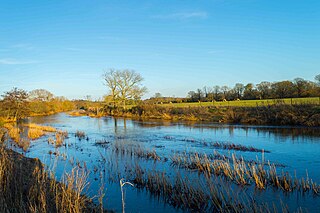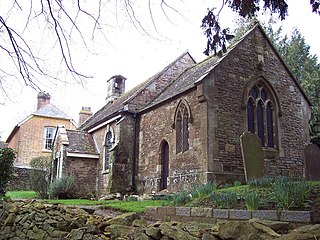
Stalbridge is a town and civil parish in Dorset, England, situated in the Blackmore Vale, near the border with Somerset. In the 2011 census the civil parish—which includes the hamlets of Stalbridge Weston, and Thornhill—had 1,160 households and a population of 2,698. The nearest towns are Sturminster Newton, four miles southeast, Sherborne, 6 mi (10 km) west, and Shaftesbury, 7 mi (11 km) northeast. Stalbridge is situated on the A357 on a low limestone ridge, one mile west of the River Stour. It officially became a town in April 1992.

The Blackmore Vale is a vale, or wide valley, in north Dorset, and to a lesser extent south Somerset and southwest Wiltshire in southern England.

Blandford Forum is a market town in Dorset, England, by the River Stour 13 miles northwest of Poole. It had a population of 10,355 at the 2021 census.

The River Stour is a 61 mi (98 km) river which flows through Wiltshire and Dorset in southern England, and drains into the English Channel. The catchment area for the river and its tributaries is listed as 480 square miles (1,240 km2).

North Dorset was a local government district in Dorset, England, between 1974 and 2019. Its area was largely rural, but included the towns of Blandford Forum, Gillingham, Shaftesbury, Stalbridge and Sturminster Newton. Much of North Dorset was in the River Stour valley, known as the Blackmore Vale. The economy of North Dorset was largely based on dairy agriculture.

Wincanton is a town and electoral ward in South Somerset, southwest England. The town lies off the A303 road, a main route between London and South West England, and has some light industry. The town and electoral ward has a population of 5,272.

Hinton St Mary is a village and civil parish in Dorset, southern England. It is sited on a low Corallian limestone ridge beside the River Stour, one mile north of the market town Sturminster Newton. In 2001 the parish had 97 households and a population of 221. In 2013 the estimated population of the parish was 260. In 2021 the estimated population of the parish has decreased to 225.

Marnhull is a village and civil parish in the county of Dorset in southern England. It lies in the Blackmore Vale, three miles north of Sturminster Newton. The resort towns of Bournemouth and Weymouth are approximately 30 miles south. Marnhull is sited on a low ridge of Corallian limestone above the valley of the River Stour, which forms the northern and western boundaries of the parish. In the 2011 census the parish had 962 dwellings, 905 households and a population of 1,998.

Shillingstone is a village and civil parish in the Blackmore Vale area of north Dorset, England, situated on the River Stour between Sturminster Newton and Blandford Forum. In the 2011 Census the civil parish had 479 households and a population of 1,170.

Stour Provost is a village and civil parish in the Blackmore Vale area of north Dorset, England, situated on the River Stour between Sturminster Newton and Gillingham. In old writings it is usually spelled Stower Provost.

Durweston is a village and civil parish in the English county of Dorset. It lies two miles northwest of the town of Blandford Forum. It is sited by the River Stour at the point where it flows out of the Blackmore Vale through a steep, narrow gap between the Dorset Downs and Cranborne Chase. In the 2011 census the parish had a population of 398.

Fifehead Neville is a village and civil parish in the county of Dorset in southern England, situated in the Blackmore Vale about two miles southwest of the town of Sturminster Newton. In the 2011 census the population of the parish was 147.

Manston is a small village and civil parish in the county of Dorset in southern England, lying next to the River Stour in the Blackmore Vale, two miles east of Sturminster Newton. The geology of the parish consists mostly of Kimmeridge clay, with a thin strip of Corallian limestone in the west.

Okeford Fitzpaine is a village and civil parish in the English county of Dorset, situated in the Blackmore Vale three miles south of the town of Sturminster Newton. It is sited on a thin strip of greensand under the scarp face of the Dorset Downs. In the 2011 census the civil parish—which includes the village of Belchalwell to the west and most of the hamlet of Fiddleford to the north—had 404 dwellings, 380 households and a population of 913.

Hazelbury Bryan is a village and civil parish in the county of Dorset in southern England. It is situated in the Blackmore Vale, approximately five miles southwest of the small town of Sturminster Newton. The parish includes the hamlets of Droop, Kingston, Parkgate, Pidney, Pleck, Wonston and Woodrow. In the 2011 census the parish had 480 dwellings, 454 households and a population of 1,059.

Hawes is a market town and civil parish in North Yorkshire, England, at the head of Wensleydale in the Yorkshire Dales, and historically in the North Riding of Yorkshire. The River Ure north of the town is a tourist attraction in the Yorkshire Dales National Park.

Sparkford is a village and civil parish in Somerset, England. The parish includes the village of Weston Bampfylde.

Sturminster Newton railway station was a station in the town of Sturminster Newton, in the English county of Dorset. It was located on the Somerset and Dorset Joint Railway.

Margaret Marsh is a hamlet and civil parish in north Dorset, England. It is situated in the Blackmore Vale, halfway between the towns of Shaftesbury and Sturminster Newton. It is sited on Kimmeridge Clay close to a small tributary stream of the River Stour. In the 2001 census the parish had a population of 60. In 2013 the estimated population of the parish was 40. The parish church has a 15th-century tower and 13th-century font, but the rest of the building was rebuilt in 1873. For local government purposes the parish is grouped with the parishes of East Orchard and West Orchard, to form a Group Parish Council.

Hammoon is a small village and civil parish in the English county of Dorset, sited on a river terrace of alluvial silt by the River Stour, about two miles east of the small town of Sturminster Newton. Its name is derived from the Old English ham, meaning dwelling, and the surname of the Norman lord of the manor. In 2001 the parish had 19 households and a population of 49. In 2013 the estimated population of the parish was 40.



























